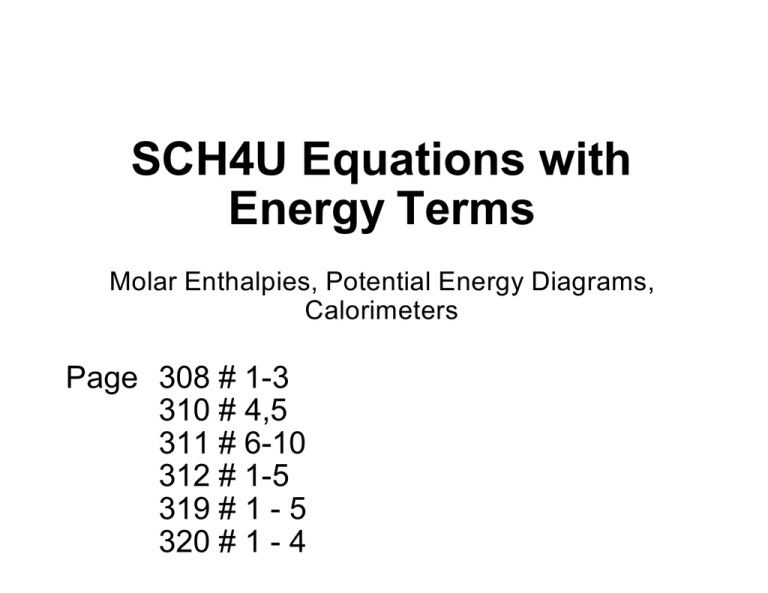SCH4U Equations with Energy Terms Page 308 # 1-3 310 # 4,5
advertisement

SCH4U Equations with Energy Terms Molar Enthalpies, Potential Energy Diagrams, Calorimeters Page 308 # 1-3 310 # 4,5 311 # 6-10 312 # 1-5 319 # 1 - 5 320 # 1 - 4 Exothermic process is any process that gives off heat – transfers thermal energy from the system to the surroundings. 2H2 (g) + O2 (g) H2O (g) 2H2O (l) + energy H2O (l) + energy Endothermic process is any process in which heat has to be supplied to the system from the surroundings. energy + H 2O (s) energy + 2HgO (s) H2O (l) 2Hg (l) + O2 (g) Change of Enthalpy, D H DH= Hfinal - Hinitial Exothermic If the products have less energy than the reactants, i.e. Hfinal < Hinitial , then DH is negative. Heat has been released. Exothermic processes have a negative DH. CH4(g) + 2O2(g) CO2(g) + 2H2O(g) Enthalpy diagram for exothermic process. Change of Enthalpy, D H D H= H final - H initial Endothermic If the products have more energy than the reactants, i.e. Hfinal > Hinitial , then DH is positive. Heat has been absorbed. Endothermic processes have a positive DH. H O( s ) 2 H 2 O( l ) Enthalpydiagramforendothermicprocess. Drawing Enthalpy Diagrams and Determining the Sign of Ä H PROBLEM: In each of the following cases, determine the sign of Ä H, state whether the reaction is exothermic or endothermic, and draw an enthalpy diagram. (a) H2(g) + 1/2 O2(g) H2O(l) O(l)++2 285.8kJ PLAN: Determine whether heat is a reactant or a product. The reactants are at a higher energy than the products. The reaction is an exothermic reaction when heat is a product. SOLUTION: (a) H2(g) + The reaction is exothermic. 1/2 O2(g) EXOTHERMIC H2O(l) (reactants) DH = -285.8kJ (products) (b) 40.7kJ ++HH 2 O( l) The reaction is H 2O(g) ENDOTHERMIC H 2O(l) H 2 O( g) endothermic (products) DH = +40.7kJ (reactants) . Examples kJ as reactant = endo + = endo H2O(s) + 6.01kJ H2O(l) Or… H2O(s) H2O(l) DH = + 6.01kJ kJ as product = exo 2C4H10(g) + 13O2(g) Or… 8CO2(g) + 10H2O(g) + 5314kJ 2C4H10(g) + 13O2(g) 8CO2(g) + 10H2O(g) DH = -5314kJ Calculate the molar heat of combustion (H CO) for butane 2C 4 H 10(g) + 13O 2(g) 8CO 2(g) + 10H 2 O (g) + 5314kJ Solution – whenweareattemptingtheseÄH problems,firstseeifthe reaction'senergyisprovidedinthequestionI.fitis,procee d to solve. If it isnot,thenwehaveamulti-stepproblem. Theenergy given may be used for every substance in the reaction I.e. It applies to the butane, oxygen, carbon dioxide and steam 2C 4 H 10(g) + 13O 2(g) 8CO 2(g) + 10H 2 O (g) + 5314kJ The energy given may be used for every substance in the reaction So,accordingtothereaction,2molesofbutanecorrespondto5314kJ. We need the amount of energy for 1 mol of butane; \H CO = 5314kJ / 2mol butane gives us H CO = - 2657kJ/mol PE diagram of ice melting H 2O(l) PE diagram of combustion of butane 2C 4H 10(g) + 13O 2(g) DH = -5738kJ DH = +6.01kJ 8CO 2(g) + 10H 2O (g) H 2O(s) Reaction Progress (min) Reaction Progress (min) **Anytime you need to answer a theory or calculation question, i t is always a good idea to sketch a graph, if applicable. *Do products/reactants have more potential energy? * Are the products or reactants more stable? Some Important Types of Enthalpy Change heat of formation ( K( s ) + 1/2 Br 2( l) 13/2 O2(g) H f) KBr( s ) D heat of combustion ( C4H10(l) + D H comb ) 4CO2(g) + 5H2O(g) Some Important Types of Enthalpy Change D heat of fusion ( NaCl( s) fus NaCl( D heat of vaporization ( C 6H 6( l) H C H ) l) vap) H ( g ) 6 6 Writing Formation Equations PROBLEM: Writb ealancee dquationfsotrhfeormatioo nm 1f ootlh f feollowing compoundfr fs srom tthheee eirirl leement mentitn hsitn sheseir irtstans andar dta sar dta tdete saand snin in dcclude lude DH0f. (a) Silvecrhloride,AgCla,solidasttandardconditions. Usethetableofheatsoformationforvalues. PLAN: SOLUTION: (a) Ag(s) + 1/2Cl2(g) AgCl(s) DH0f = -127.0kJ (b) Calciucm arbonatCea,CO 3a,solidasttandardconditions. Ca(s) + C(graphite+ )3/2O2(g) CaCO3(s) (c) DH0f =-1206.9kJ HydrogencyanideH , CNa,gasasttandardconditions. 1/2H2(g)+C(graphite)+1/2N2(g) HCN(g) DH0f1=35kJ Specific Heat Capacity Wheanonbjecatbsorbhseagitt,ethsotter. Thm e orh eeaa itbsorbtshh eotteg irtets, i.e.q ~DT or q =constant xDT or q /cD=o Tnstant This capacity of an object to absorb heat is called its: D (units of J/K) The amount of heat to change the temperature by 1 K heatcapacityq =/T SpeciH fie cCaatpac(icty) A related property is This is the amount of heat to change the temperature of 1 gram o f substance by 1 K c q D (units of J/g-K) = /massx T Another property is MolH aerCaatpac(itCy) This is the amount of heat to change the temperature of 1 mole o f substance by 1 K C q D (units of J/mol-K) = m / olesx T Sample Problem 6.3 PROBLEM: Calculating the Quantity of Heat from the Specific Heat Capacity lA ayce oorfppe wreldeth o dbeottosa om kfillw eteigh1s25g. Hom wuchheniaset0ederto a d0isth ete emperatutrohefe copplaeyrfreo2rm 5 tC 3o00.TC hs? epecifhicecaatpacity o (c C)f0 iu s.387J/g-K. Givtm e hn e asspse , chife cicap t acacin th ydatn ein g meperature, w e canuse q=cxmassxDtTfointdhaenswer. DTin0Cisthesameasfor K. SOLUTION: .87J x125g x3 0C 3x10 4J 1.3= q= 03 ( 0 0-2 5 ) gK * PLAN: Calorimetry Calorimetry is a way to measure heat from a process by directing the heat into “surroundings” where the increase of heat can be measured. The surroundings will be a container called a calorimeter. Theheatlostbythesystemequalstheheatgainedby thcealorimeter. - q sample = qcalorimeter (minu sisgfhonerla otst) Cofca e-clo urpimeter - q sample = qcalorimeter - (mass x heat capacity x (mass x heat capacity x Dsamp Dca.l T) T) = Sample Problem 6.4 Determining the Specific Heat Capacity of a Solid 2A5.64sgampso laeoflw idahseateta ien dtsutbt1e o00.00 oCin boiliw ngataecnradrefualldycdoatefofdee-ccuaplorimeter containi 5 n0 g.w T 0 o w 0 h a fa g e t e t t e e r . m r peratu in re c r easfe r o d m o oCh.a 251 .02 tC o8.49W tishtsepecifh iceactapacitotyhfseolid? (Assuma thehlleegiasatinebth dw yeater). ihIstelpfutuolstae ablte soummariztehdeatgaive Tnh.ewor n tkhe problerm ealizinth gh ae t laotbsthytseystem mubsee tquta that ol gstauhirbn eryo eu dndings. PROBLEM: PLAN: Mass(g) c(J/g-K) solid 25.64 c 2 50.00 4.184 HO SOLUTION: T inital n fial T 100.00 28.49 25.10 28.49 D T -71.51 3.39 25.6 x 4g cx -715 .1K =- 50.0 x 0g 4.18J/g-Kx 3.K 39 csodil = - 50.0 x 0g 4.18J/g-Kx 3.K 39 = 0.387J/g-K 25.6 x 4g -715 .1K boAcmablorimeter -qsampel =qcaolrm i eter qcaolrm i eter h =eactapacitx DyT Sample Problem 6.5 Calculating the Heat of Combustion mAanufacturcela r im thnistae sdtw ietedtie cssehr“atfsewer tha1nC 0aloriepsesrervinTg toe.”sthtcelaim cah,emisat th Deepartme Coonft summer Affaip rslaceosnseervinaing bomb cao l rm i ater anbdurniiO n st 2(thheea ca t pacio t0h yfe calorim 8.e 1=tT 5teekhrm Je/p Ke).ratiunrcereas 4e.9s37 C. m thaeInsufacturcelcra'o sim rrect? -qsampel =qcaolrm i eter PROBLEM: PLAN: SOLUTION: qcaolrm =eactapacitDxT y i eter h 8=.1514kx.9 J/3K7K 40.= 24kJ 402 .4kJ kcal 9.= 62k Cocaa rlolries 41 .8kJ Tmhaenufacturectrrluai'seim .






